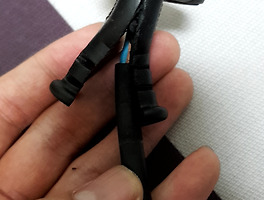Creo에서 모델을 만들 때에는 Parametric을 사용래해서 만들고, 만든 작업 파일을 켜면 기본적으로 시뮬레이트로 실행됩니다.
Creo 다운로드/설치법은 이전 포스팅에 있구요.
이때 라이센스가 없다는 문구가 뜨며 할 수 있는 건 모델을 이러저리 보는 것 뿐인데요.
완성한 모델이 시뮬레이트 프로그램을 통해 켜지는 건,
모델을 만들 때 형태만 만드는 것이 아니라 재질을 설정하고 무게도 설정하고 하중도 가상으로 가해 보고 해야 실제로 제품을 만들기 전에 많은 것을 실험해 볼 수 있기 때문에 그러한 기능이 있는 프로그램으로 설정되어 있는 것입니다.
하지만 학생용 무료버전은 정식 버전이 아니기 때문에 이 기능의 전부는 사용할 수 없구요.
대신 시뮬레이트의 경량화된 버전, Simulate Lite기능을 사용할 수 있죠!
그걸 위해선 먼저 모델 파일의 연결 프로그램을 바꿔주어야 합니다.
속성에서 연결 프로그램을 보면 Creo Simulate의 아이콘입니다.
변경을 누르고 추가 앱- 이 PC에서 다른 앱 찾기-
C:\Program Files\PTC\Creo 4.0\M030\Parametric\bin 폴더에 있는 parametric.exe를 클릭하고 열기하면
아이콘이 패러메트릭 프로그램으로 바뀐 것을 확인할 수 있습니다.
이제 적용하고 속성창을 닫은다음 모델 파일을 열어줍시다.
Simulate Lite는 Parametric 안에서 사용할 수 있는 기능이기 때문인데요.
주목할 것은 이 응용 프로그램 탭입니다.
놀랍게도 이쪽에도 Simulate기능이 있죠.
클릭하면 이번에도 License Check이라며 동일한 문구가 뜨는데요, 일단 아 그런가보다 하고 확인을 눌러줍시다.
그러면 화면 왼쪽이 창이 하나 뜨는데 Simulate Lite란 단어가 보이죠?
박스에 체크하고 OK 해줍시다.
그러면--
시뮬레이트 기능으로 성공적으로 넘어왔군요.
단, 여기부터는 한글화가 되어있지 않습니다. 또한 기능에도 어느정도 제약이 있다는 것도 알아두고 사용해 주세요.
아래는 Simulate Lite의 기능에 대한 설명 전문인데요,
모델 하나당 합쳐서 개별적인 표면 개수가 200개 미만까지는 별 문제 없이 사용할 수 있다고 합니다.
예를들어 직사각형은 표면이 6개고 육각기둥은 표면이 8개고 하는 식으로 카운트되는 것 같군요.
자동차 엔진같은거 모델링 하는 경우 아니면 배우는 용으로는 충분한 것 같네요. 번역하기엔 너무 많아서 안할게요ㅎㅎ
About Creo Simulate Lite
Creo Simulate Lite is the limited functionality, trial version of Creo Simulate. You can use Lite mode for part or assembly models with upto 200 surfaces. You can access Creo Simulate Lite with a Creo Parametric license.
Lite mode is only available in the integrated, native, structure mode. You can create a simulation model, run a static analysis on it and evaluate the results.
If you open a model created in standard Creo Simulate in Lite mode, Creo Simulate entities are deleted in the model. If you have a standard or advanced Creo Simulate license, you can convert a model created in Creo Simulate Lite to a standard Creo Simulate model.
The user interface to Creo Simulate Lite is provided through the Process Guide, a tool that guides you in:
• Creation of modeling entities
• Application of constraints
• Application of loads
• Running analyses
• Reviewing results of analyses
You can perform the following tasks:
• Assign Materials—Assign a material to the model. The Material Assignment dialog box opens. Material orientation is not available in Creo Simulate Lite.
• Apply Constraints
—Apply structural constraints to entities in your model to fix portions of your model geometry so that they cannot move, or move only in a predetermined way. In Creo Simulate Lite you can apply the following constraints to model entities:
◦ Displacement Constraint—Controls the translation of an entity in your model.
◦ Planar Constraint—Controls off planar movement of a surface in your model.
◦ Pin Constraint—Controls the translation and rotation of a cylindrical surface.
◦ Ball Constraint—Controls the rotation of a spherical surface.
• Apply Loads—Apply structure loads to entities in your model to simulate the real world environment that your model can encounter. You can apply the following structure loads to your model:
◦ Force Load—Applies force loads to selected surfaces, edges or points on your model.
◦ Pressure Load—Applies a pressure load to a selected entity in your model.
◦ Gravity Load—Creates an acceleration load on your model.
• Run Analysis—Run a static analysis for a single constraint set and a single load set in Creo Simulate Lite. A static analysis calculates deformations, stresses, and strains on your model in response to the loads and constraints you specify.
• Review Results—View the following Result windows:
◦ An animated fringe plot of Von Mises stress for the model.
◦ A fringe plot of displacement magnitude for the model.
◦ A vector plot of the maximum principal stress for the model.
'잡동사니 백과' 카테고리의 다른 글
| 전원코드 고치기(인덕션) (0) | 2019.01.26 |
|---|---|
| 연결된 스피커 또는 헤드폰이 없습니다 오류 해결법 (0) | 2018.08.22 |
| Creo 4.0 학생용 환경설정하기 (0) | 2018.02.20 |
| Creo 4.0 학생용 다운로드/설치 가이드 (2) | 2018.02.19 |
| 남는 배터리로 보조배터리 만들기 (0) | 2018.02.07 |











